Subscribe to blog updates via email »
June 2023 Income Report
To listen to an audio version of this report, join the Patreon »
June’s income was $6,714, down from May’s $6,912. Profits were $4,441, up from May’s $1,588.
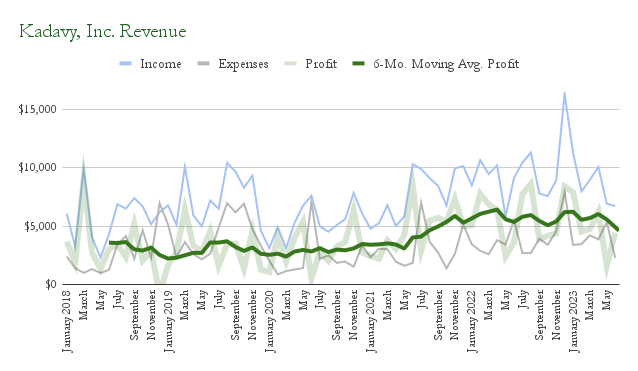
Slow book sales
Slower book sales continue, though I’m not spending so much of my income on ads. In May, I made $959 profit on books, on $4,753 ad spend. In June, I made $1,876 profit on books, on $1,719 ad spend.

WANT TO WRITE A BOOK?
Download your FREE copy of How to Write a Book »
(for a limited time)
But, I only sold 513 copies of Mind Management, Not Time Management in June, relative to 773 in May. However, surely some of the copies sold in June were thanks to the high ad spend in May.
As I mentioned last month, I’m tempted to attribute much of this decline in sales to it being summer – the first real post-COVID summer. According to a poll I did on Twitter, 15% of people said they’re taking this summer their “first big trip since the pandemic.” (Though I have nothing to compare to.)
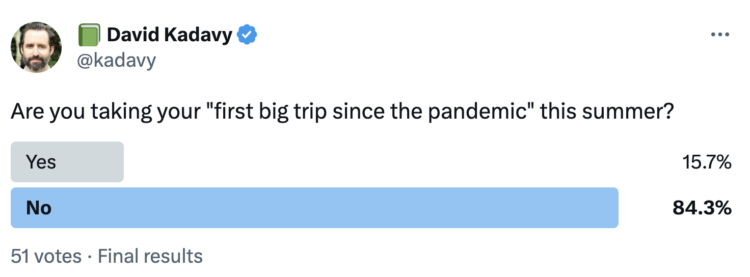
But there are other causes I suspect for the decline in sales, including changing attitudes about reading, in the wake of the ChatGPT frenzy. Though according to a Twitter poll, only 6% claim to have changed their reading habits due to ChatGPT.
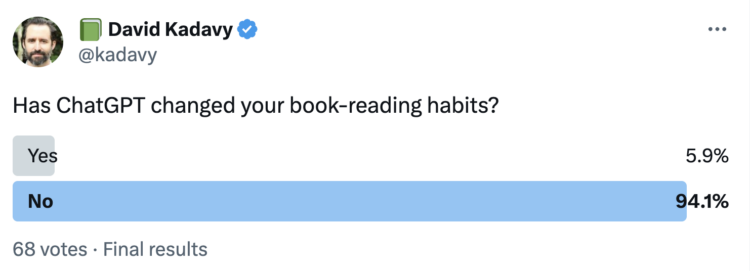
Also, it could be that the publishing industry is flooded by AI-generated books, which may explain the skyrocketing costs of Amazon ads.
Temporary changes and permanent
I’d like to think some of this is a temporary change, and will subside – that a bunch of people are toying with uploading low-quality AI-generated books, and they’re driving up ad prices, and will eventually run out of money to burn when they realize it’s not that easy.
But in some way the industry has probably changed forever. That seems to be the opinion of Joanna Penn, according to her recent podcast episodes and answers to her Patreon Q&As. I’ll talk later about some of the things I’m doing to compensate against this recent, perhaps-not-temporary, decline in online sales.
Back from Italy
I’m back from my research trip in Italy. When I published last month’s income report, I was in the midst of a two-week stay in Rome, and just back from a short excursion to Naples, Pompeii, and Capri.
I followed up two weeks in Rome with a week in Florence, including a day-trip both to Machiavelli’s farm and vineyard, and Leonardo da Vinci’s birthplace…Vinci.
I remembered this time to take some selfies at several sights.

On Machiavelli’s farm
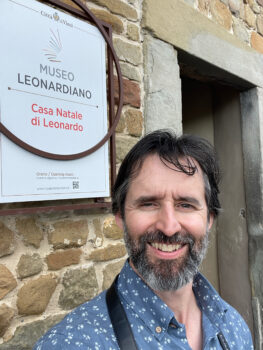
At Leonardo Da Vinci’s birthplace
Then, I went to Venice for one night, Milan for two, and finished up the trip with an overnight layover Madrid.

In Venice, just after seeing a bird steal food from a woman’s hand.

At Biblioteca Ambrosiana taking in displays of Leonardo’s Codex Atlanticus

Myself and 34 others were allowed to view The Last Supper for 15 minutes. Tickets sold out two months in advance.
I saw a ton of work by Leonardo and Raphael on this trip. I really gained a lot of appreciation for what an amazing and prolific painter Raphael was, and how few completed works there are to see of Leonardo’s. I saw a lot more of the former than the latter, that’s for sure!
Quitting podcasting, taking a book-writing break
I’ve traveled plenty since the onset of the pandemic, but this was the first long trip in years that I really looked forward to, and wasn’t due to responding to some family tragedy or visa complication. Being out of the house and my home countries for a month really shook some cobwebs that had built up in my routines and work. I invite that kind of disruption, but it is just that – a disruption.
I managed to keep the podcast on schedule during the trip, but upon returning, I realized I just wasn’t psyched to record more episodes. I’ve long thought about quitting the podcast, but I was still getting value out of having it as a place to share my ideas, as I worked on the final book in the Getting Art Done trilogy.
Not ready to finish Finish What Matters?
But the more I thought about Finish What Matters, the more it felt like not only should I quit the podcast, maybe I should also take a break from writing this final book.
I’ve dug deep the past few years on finishing creative work: What does it mean to finish? Why do we get shiny object syndrome? How can you feel reassured a creative project will be successful when nobody knows anything?
Finishing creative projects is full of confusion over what matters, in terms of odds of success. The unique perspective I hope to share in Finish What Matters is how to navigate that confusion.
But as I’ve thought about what matters, I’ve been thinking of another interpretation of that word. What matters to me, as a person, to finish? Finishing something that matters to you is one form of success, after all, and struggles to finish often stem from a lack of clarity in what matters to you.
From what pain is this book born?
I came to realize the first couple books in this series came from very apparent sources of pain. The Heart to Start was me reflecting on my struggle to come to believe my ideas had value, and Mind Management, Not Time Management was me trying to find the energy to be creative on command.
Why was I writing Finish What Matters? From what source of pain was it being born? Until recently, if I asked myself, much of it was coming from a desire to finish the trilogy. But by focusing on finishing the trilogy, it seemed I might be avoiding something else I could learn from this process.
I’ve long told myself, As soon as I finish this trilogy, I’ll take a break from writing about creative productivity, and actually create something unrelated to creative productivity. But maybe I shouldn’t wait.
Bit by bit, closer to my core
I’ve followed a process of getting closer and closer to my “core” the entire sixteen years I’ve been on my own. I started with consulting and built passive income. I built passive income, and wrote my first book. I went from writing a book about what I already had expertise in, to exploring things I was learning along the way.
Bit by bit, I’ve gained more comfort with taking my ideas seriously, as something to be valued, and with putting my ideas into the world. In recent years, I’ve been experimenting with lots of other creative projects on the side, such as writing under pen names. (One of my pen names already has a few short stories on Kindle!)
And I’ve come to realize, this is something I need to learn in the course of writing Finish What Matters. This is the pain point this book needs to help me with: being brave enough to commit resources to creative projects that have no clear chance of financial success. Embedded in that process is learning to believe my ideas matter, even if they have no practical purpose or way to make money.
Does the podcast still matter?
So wrapped up in this thought process was the podcast. I came to realize I’ve already explored on the podcast enough of the ideas I want to cover in Finish What Matters. I don’t think I crossed that point terribly recently, but after coming back from this trip, it felt like to keep sticking to my production schedule would be finishing for finishing’s sake. Finishing because it meant something to my identity.
One story I briefly told myself was, You can’t write a book about finishing and stop finishing podcast episodes. But that’s where matters came in. In many ways, the podcast has stopped mattering.
It’s stopped mattering in what I want to get from it. In the beginning, it was to create a show I wanted to listen to. I wanted to learn from entrepreneurs I admired. After I had done enough of that, it was a place to explore my own ideas. Now I think I’ve done enough of that.
What’s next is finding out what’s next
An important part of finishing projects is allocating your resources so that you can give what matters the energy it deserves. But that can be a trap: You can’t decide what matters if you don’t have the space to explore.
In the “Raphael” world, of executing on ideas that are well-established, it makes no sense to quit something, without a plan for what’s next. Don’t quit your job as a bricklayer until you’ve secured one as a steamfitter. But in the Leonardo world, not knowing what’s next is an important part of the journey of deciding what matters. It is, in fact, how my journey began.
As I said of my first day of self-employment in my ten-year reflections:
I opened my eyes to vastness. There was nothing but time to be filled, like I was just floating in space…. My mission was to reconnect with my curiosity…
It’s been a long time since I had some vastness to fill. That’s been wonderful. Once I gained the courage to follow my curiosity, and had some success at it, there were plenty of ideas waiting in the wings I wanted to execute. But, not flush with cash, I went with the safer ideas that had a somewhat-clearer chance of making money.
Closing doors, burning boats
Now I own a house, have low monthly expenses, a permanent-resident visa, and an okay income. A pattern I’ve seen over and over in my business is that as soon as I get to what I feel is a good amount of financial security, my interest in what brought me that security starts to peel away, as some unconscious creative urge starts to swell.
Many times, I’ve hung on a little too long to the fragments of what worked, beyond the point at which it still works for me. I’ve tried to shoehorn my personality into being an executor, when really I’m a creator. I’m more experimental than conceptual. I’m less Raphael than Leonardo.
I could’ve taken my passive revenue muses much further, I could’ve parlayed Design for Hackers into a consulting firm, and I could bang this creative-productivity drum the rest of my life.
But I can’t. Because that’s not me.
At the same time I still have that tendency to want to keep the door open. So I have to make a conscious effort to quit things, to burn my boats.
And so the podcast seems to have run its course. I’m quitting to make space for something new. I hope in the process I’ll learn something I can teach in Finish What Matters.
(Though in the back of my mind, I remind myself, I can always publish another episode if I want.)
My lifetime wage for Love Your Work: $6/hr
I’ve tallied up my earnings for the nearly eight years of Love Your Work, through the end of June. (The last episode will go live in August.)
Revenue
- Sponsors: $13,749
- Swag Sales: $125
- Patreon: $17,470
- PayPal Donations: $487
- Total: $31,831
Expenses
- Equipment: $241
- Hosting: $1,088
- Editing: $11,749
- Swag Printing: $241
- Software: $137
- Total: $13,456
Profit: $18,375
Hours Worked: ~3,060 (Assuming 10 hours per 306 episodes)
Hourly “Wage”: $6
Of course there’s something absurd about reducing all the direct non-monetary and indirect monetary benefits I got from producing Love Your Work to an hourly wage. I made priceless connections and learned priceless lessons. I built my skills in writing, voiceover, audio and even video production, marketing, and project management. I gained clarity on what I want, and confidence on my ability to get it.
And there’s something absurd about even trying to count the hours I worked on the podcast. When I was reading a book I was interested in, to interview a guest, was I working on the podcast? When I was taking notes on a book on which I later wrote a summary, was I working on the podcast? If so, I worked many more hours than estimated.
But, such is the blunt instrument of accounting, and of Platonification in general. You have to make decisions somehow, and this is some information I’ve decided supports my decision. This has been a lot of work with little direct financial reward. Though I’m making space for some unknowns, I hope to use some of that space to grab some low-hanging fruit.
Wow, $30,000?! Wait…
At first glance, I was surprised I had made over $30,000 on the podcast. I was heart-warmed all those $5 Patreon payments – though sometimes much more – added up to more than half that. But when I consider this $30,000 is over a nearly eight-year period, and that during that period I earned nearly $600,000 revenue, it doesn’t look so impressive.
Surely, some of the other $570,000 was driven by the podcast, and no doubt at all information in the books I sold to make that revenue came from the process of making the podcast. But $30,000 is about 5% of $600,000, and I spent way more than that portion of my time and energy on the podcast. I wouldn’t be surprised if it were 50%.
What about the Patreon?
While much of my non-podcast revenue certainly was driven from the podcast, some of that podcast revenue certainly was not driven by the podcast. In particular, while my Patreon has long been ostensibly about the podcast, I sense many of my members are not supporting because of the podcast.
I notified my Patreon supporters of my decision to quit the podcast, explaining that I’d of course understand if they cancelled their memberships, but as of yet, that hasn’t driven many cancellations.
I’ve been simplifying the Patreon in recent months, and loading it up with bonus content, such as a members-only podcast called Coffee w/ Kadavy, and access to Literature Notes in my Zettelkasten. Audio versions of these income reports, once only for higher-tiered members, are now available to members at the single-tier rate.
I plan to keep creating this bonus content, and experimenting with other content, should ideas come. Overall, I’ve been looking for opportunities to spend more time in the “Cozy Web,” and creating for my most attentive readers is a great way to do that.
What about existing episodes?
Including the final episode of Love Your Work, there are 308 in total. (I think that’s an excellent run.) I’ll keep spending the $5 a month hosting fees to keep those episodes available.
Given the value of burning your boats, and my difficulty with closing doors, I probably should pull the plug on all those episodes at some point. Maybe sell them as an “audiobook” through BookFunnel. But if that ever happens, it will probably be a long time from now.
Podcast engagement numbers
Part of my loss of interest in producing the podcast has come from the realization that it has low engagement. I never could have told that looking at the IAB-standard stats on Libsyn. I had to do some digging.
One of the first clues was that when I took my usual break in December, nobody asked why there weren’t more podcast episodes, but they did ask why there weren’t more “articles.” To improve SEO performance and accessibility, and because my essay episodes are scripted anyway, I’ve been publishing the entire text of each episode along with the audio. That gets sent out to email subscribers to kadavy.net posts. So it seems a good portion of people don’t even know they’re reading a podcast. Some seem to think it’s a “newsletter”, which is what I consider Love Mondays to be.
Apple Podcasts and Libsyn numbers don’t match up
One day when I logged into Apple Podcasts, I realized I had very low engagement numbers. The graph over the past eighteen months looked like this.

That seemed weird, as my Libsyn downloads graph looked like this.
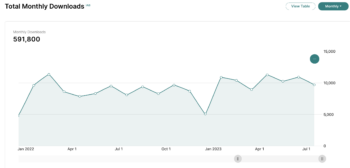
Libsyn’s stats follow IAB standards. That means that if an advertiser wants information on my podcast listenership, they should be able to trust these numbers. But, Libsyn only has access to download data. Apple Podcasts has all the data they want about actual listening behavior.
By cross-referencing the percentage of my downloads that, according to Libsyn, were from Apple Podcasts users (66%), I extrapolated that my most popular episode (55 engaged listeners in Apple Podcasts), must have had about 83 engaged listeners overall. (An engaged listener is someone who listened to at least 40% of the content.)
83 is a pretty low number, considering that the IAB-standard number of downloads for that episode, according to Libsyn, was 1,770!
Verifying low engagement with engagement tests
To be sure, I ran a couple tests. One, I asked up-front in an episode for reviews on Apple Podcasts. Many hosts ask for this in every episode, and I used to, but I hadn’t for years. Surely there were lots of listeners I’d accumulated who had never thought to review the show, and if they were reminded, would.
Two, I temporarily gave away my book, How to Write a Book. I announced the link at the beginning of an episode, and didn’t even mention it in the show notes. One could only find out about it by listening.
Reviews? I got pretty much none. I think I had one that was clearly an interview-booker trying to butter me up, and well after the episode went live, another one from a personal friend.
And when I was giving away a book for free? According to BookFunnel, the free book was claimed five times.
If I can only give away five copies of a book, how many books am I really selling by publishing on my podcast? My guess is not many.
Listenership declined with COVID, and final interview
It seems active listenership declined with the onset of COVID, which I soon followed with my last interview episode.
I expected to some extent listenership would decline without interviews – and a fortnightly instead of weekly publishing cadence – but felt it was worth it to have the extra space to explore my ideas. Seeing now how severely my listenership dropped when I stopped doing interviews, I posit many of those listeners were there just for the guests.
Did I gain new followers of my own ideas by interviewing others? If I look at my own behavior, I would guess not. If I want to hear an interview of someone, I search their name. It almost doesn’t matter how good the interviewer is, I’m not likely to seek out more of their work.
Exploring this freed-up space
I still have to finish up and record my final, farewell episode, but it’s so far been a relief to have this extra space. Making the podcast felt like a Sisyphean effort when I was trying to make it big. It felt less so like that when I started looking at it as a place to test ideas. But now that I don’t have podcast deadlines staring me down, I realize it had still felt Sisyphean: Writing articles that were maybe a little too long, because that’s how much editing time I was paying for, reading them into a microphone when good text-to-speech options exist, realizing maybe eighty people are actually listening.
Meanwhile, I can put less effort into a reel on TikTok or Instagram and get thousands, sometimes tens-of-thousands of views, and hundreds of likes. Granted, that’s still ephemeral engagement compared to a podcast listener, and that’s building on rented land. One great thing about a podcast feed is you have a direct line to your audience. But when I also consider I can spend much less time and effort on my weekly newsletter, and get plenty of notes of appreciation, and I have an even more direct line to my audience, it’s hard to justify the podcast effort any longer.
I’ll still publish articles on my blog. They’ll still go out to email subscribers. What length those articles will be, and at what cadence, I don’t yet know.
For now, I’m enjoying having a little more space to figure out what matters. I’m still making sloppy operating procedures, as I explore different sizes, shapes, and batter contents of “cupcakes”, and what processes I’ll follow to make and apply the frosting and sprinkles.
Building my Shopify store
While I hope to use my freed-up time and energy from quitting the podcast to explore some things that have little chance of making money, I always want to use it for some things that have a better chance of making money.
With the changing landscape in publishing, one of those things is focusing more on direct sales of my books. I’ve been dabbling in that for a few years now, using PayHip, but since I’ve run into some limitations with that, I now have a Shopify store. I had long wanted to try out Shopify, but it wasn’t until I recently learned they have a limited-feature $5/month Starter plan that I finally went for it.
I’m using BookVault to print and fulfill paper books, and BookFunnel to deliver ebooks. I’m also a beta user of BookFunnel’s audiobook fulfillment features. The audiobooks I sell through PayHip are just MP3 downloads, and that can be a hassle, so I’m excited to provide an option through which readers can listen on an easy app.
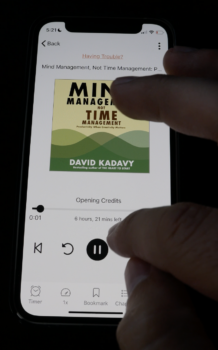
You can now enjoy the MMT Audiobook on the BookFunnel app.
The higher margins of selling direct
On the surface, it seems selling direct offers higher margins. For example, here are the numbers on the MMT Hardback, considering a $28 price.
IngramSpark
- Printing: $11.02
- Royalty Rate: 70%
- Profit: $8.58
BookVault
- Printing: £7.51 ($9.65)
- Royalty Rate: N/A (i.e. 100%)
- Profit: $18.35
Again, that’s on the surface. A couple downsides of selling direct through Shopify and printing and fulfilling through BookVault:
- Books print in the UK. Therefore, they take about three weeks to reach a customer in the U.S. BookVault is now slowly rolling out U.S. printing, but it’s available for limited book specs (i.e. not a dust-jacketed Hardback), and doesn’t yet work with orders generated through Shopify.
- This doesn’t include shipping. If a U.S. Amazon Prime customer orders my MMT Hardback – fulfilled by IngramSpark – they pay no shipping. If they order through my Shopify store, somebody has to pay £8.68 ($11.17) shipping. If that’s me, now I only make $7.18. If it’s them, well, that’s a lot to pay for shipping.
eBook and Audiobook today – hard copy arrives in three weeks
I can’t beat Amazon’s economics when it comes to shipping books (and printing books, where applicable – they can’t print a dust-jacketed Hardback like MMT’s). So I need to think of other ways to make ordering direct a no-brainer for some customers.
I heard a great idea from Derek Sivers on The Creative Penn Podcast recently: He offers electronic formats immediately, while the customer waits for the hard copy to arrive.
That’s not going to be enticing for everyone – I personally prefer to consume in only one format. But according to an informal Twitter poll, at least half of people would rather have the electronic formats today, and the hard copy in three weeks, than just get the hard copy in two days.
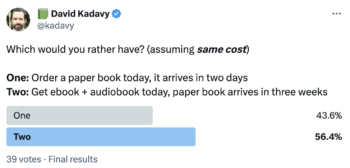
So, I set out to offer the eBook and Audiobook free (where available) when buying a hard-copy book. This was a little complicated – BookVault orders aren’t compatible with Shopify bundles. But, I have it set up now so that if you add all formats to the cart, the electronic formats will be free.
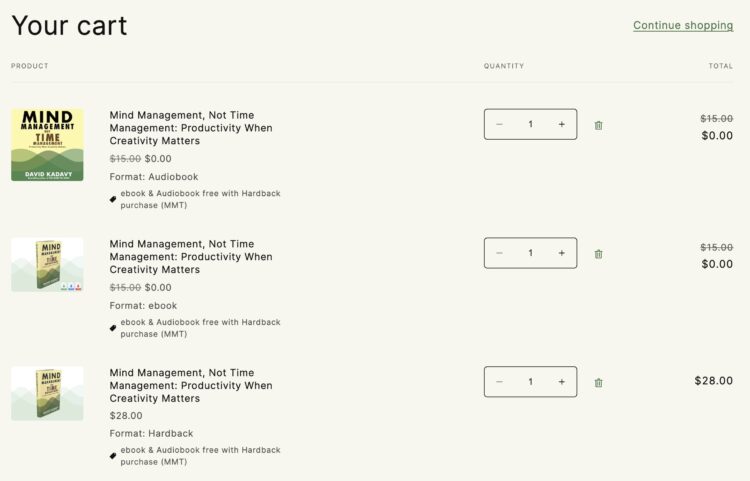
If you add all formats of a book to your cart on my Shopify store, the electronic versions will be free.
Other ideas
I’ll keep thinking of ways to make it enticing to order direct from me. Another idea Derek Sivers had was offering additional books beyond the first at a steep discount. I tried this but couldn’t get it to work in combination with the free-electronic-formats deal. Also, shipping gets much more cost-efficient when multiple books are ordered, so it will make sense to offer free shipping when ordering some number of books.
Still on Starter plan
I’m still on the Shopify “Starter” plan, which is very limited in terms of design and available plug-ins. I’m slowly directing small amounts of traffic to the store, and getting a few orders. I want to make sure there aren’t any obvious snags in the process before marketing it terribly widely.
I would like to build up to at least the Shopify Basic plan at some point, but it’s $29 a month, so there’s some threshold at which that will make sense.
Now tracking direct sales
As I experiment more with direct sales, I’d like to know what portion of my sales are direct. So, I went through my data and developed this graph.
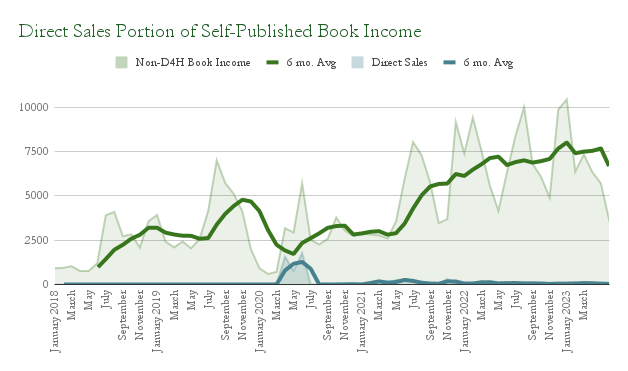
As you can see I had a big bump up a few years ago, when Digital Zettelkasten debuted (that crowd buys direct a lot!), and when I was selling the Preview Edition of Mind Management. Since then, direct sales have come in a trickle – an average of only $52 a month so far this year.
That doesn’t justify spending $29 a month on a Shopify Basic plan. I’m not sure at what threshold it will start to make sense. It could be, $300 a month for three months, or $500 a month for six months. I need to consider that whatever my revenue numbers, I still need to pay to print these books.
I do want to see how far I can take it without the extra features of the Basic plan.
Returning to 20BooksTo50k
Before I went to the 20BooksTo50k conference last November, I was 70% sure I would not return in 2023. After I went, I revised that to 40%. Now, I am only 10% sure I will not return (which is about as aggressive a prediction I’ll make about anything).
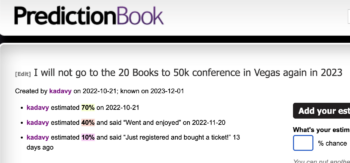
In other words, I bought a ticket! I hope to keep up with how AI is changing the industry, and trade tips on direct sales.
Will have a table at RAVE
This year, I’ll have half a table at RAVE, which is an event in which authors sell their books directly. I sort of casually got the table, but now I’ve realized: Wow, I have no experience selling my books in-person at a conference.
I’m still not exactly sure what my strategy will be: Is my goal to sell books, or make connections – e.g. get email subscribers? If it’s to sell books, that can get complicated, as I have to be careful to have the right amount of inventory, since it’s not convenient to lug a bunch of books back to Colombia. If I want to get email subscribers, I could have a few sample books on-hand, and anyone who wants to buy could go through my Shopify store and get electronic formats while their hard copy prints.
I’m also thinking of how to stand out in such a crowded event. Maybe I’ll bring my typewriter? Maybe have index cards that hold about 100 words? Maybe encourage people to come start their 100-word writing habit on my typewriter? That could be fun.
Will keep thinking about this.
Submitted a SXSW talk
Part of the motivation in building my Shopify store and selling at a table at 20 Books is heeding the advice of Joanna Penn about doing more in-person things. Not the easiest thing to do when I live in Colombia.
I’ve thought the past couple years about doing another SXSW talk. I talked there a long time ago – in 2011 and 2012! I’ve done no in-person speaking events of any kind since 2015. I kind of told myself I was quitting for a while.
But after I got back from Italy, it suddenly felt like a good idea to submit to speak at SXSW next year. I think the contents of Mind Management, Not Time Management could be condensed into a solid hour-long talk. So, I submitted a talk. You’ll probably hear from me soon, asking for your help in voting for it.
I’ve done so many reps in preparing to talk about things for my podcast, speaking again oddly doesn’t sound so intimidating. I could be forgetting how much work it is. I do know I want to visit Austin sometime soon, whether for SXSW or otherwise. Short bursts of time around people in my industry is a part of my barbell strategy, the other side of the barbell being living in a cabin in rural Colombia.
Income
Book Sales
| Mind Management, Not Time Management Kindle | $554 |
| Mind Management, Not Time Management Paperback (Amazon) | $678 |
| Mind Management, Not Time Management (non-Amazon) | $368 |
| Mind Management, Not Time Management Audiobook | $430 |
| 100-Word Writing Habit | $473 |
| Digital Zettelkasten Kindle | $466 |
| Digital Zettelkasten Wide (non-Kindle) | $148 |
| Digital Zettelkasten Audiobook | $55 |
| The Heart to Start Kindle | $114 |
| The Heart to Start Paperback (Amazon) | $119 |
| The Heart to Start “Wide” (non-Amazon) | $14 |
| The Heart to Start Audiobook | $41 |
| How to Write a Book Kindle | $26 |
| How to Write a Book Paperback | $86 |
| How to Write a Book “Wide” (non-Amazon) | $10 |
| How to Write a Book Audiobook | $9 |
| How to Write a Book Spanish (all) | $0 |
| Make Money Writing on the STEEM Blockchain (all) | $0 |
| Ten Passive Income Ideas | $4 |
| Total Book Sales | $3,595 |
Digital Products
| Summer of Design | $0 |
| Total Digital Products | $0 |
Affiliates / Advertising
| Active Campaign | $2,265 |
| Alliance of Independent Authors | $643 |
| Amazon | $26 |
| SendOwl | $5 |
| Total Affiliates | $2,939 |
Love Your Work Podcast
| Patreon | $179 |
| Total LYW Podcast | $179 |
Services
| Clarity | $0 |
| Medium | $1 |
| Total Services | $1 |
| GROSS INCOME | $6,714 |
Expenses
General
| Accounting | $0 |
| Book Printing | $49 |
| Outside Contractors | $0 |
| Podcast Editing / Publishing | $123 |
| Quickbooks | $49 |
| Total General | $221 |
Advertising
| Amazon | $1,651 |
| BookBub | $68 |
| $0 | |
| Influencer Marketing | $0 |
| Product Samples | $0 |
| Total Advertising | $1,719 |
Hosting
| ActiveCampaign | $135 |
| Bookfunnel | $15 |
| Drafts | $2 |
| Dropbox | $10 |
| Fathom Analtyics | $14 |
| Libsyn | $7 |
| Namecheap | $0 |
| Obsidian Publish | $10 |
| SendOwl | $9 |
| Shopify | $3 |
| Twitter Blue | $8 |
| Ulysses | $3 |
| WP Engine | $96 |
| Zapier | $14 |
| Zoom | $8 |
| Total Hosting | $334 |
| TOTAL EXPENSES | $2,273 |
| NET PROFIT | $4,441 |



